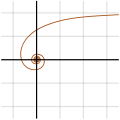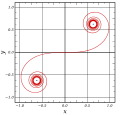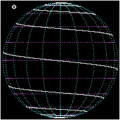Spiral
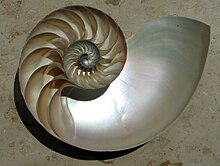
In mathematics, a spiral is a curve which emanates from a point, moving farther away as it revolves around the point.[1][2][3][4] It is a subtype of whorled patterns, a broad group that also includes concentric objects.
Helices

Two major definitions of "spiral" in the
- a curve on a plane that winds around a fixed center point at a continuously increasing or decreasing distance from the point.
- a three-dimensional curve that turns around an axis at a constant or continuously varying distance while moving parallel to the axis; a helix.
The first definition describes a
The second definition includes two kinds of 3-dimensional relatives of spirals:
- A conical or conical helix.
- Quite explicitly, definition 2 also includes a cylindrical coil spring and a strand of DNA, both of which are quite helical, so that "helix" is a more useful description than "spiral" for each of them; in general, "spiral" is seldom applied if successive "loops" of a curve have the same diameter.[5]
In the side picture, the black curve at the bottom is an Archimedean spiral, while the green curve is a helix. The curve shown in red is a conical spiral.
Two-dimensional
A
The circle would be regarded as a
).In --coordinates the curve has the parametric representation:
Examples
Some of the most important sorts of two-dimensional spirals include:
- The Archimedean spiral:
- The hyperbolic spiral:
- Fermat's spiral:
- The lituus:
- The logarithmic spiral:
- The Cornu spiralor clothoid
- The Fibonacci spiral and golden spiral
- The Spiral of Theodorus: an approximation of the Archimedean spiral composed of contiguous right triangles
- The involute of a circle
-
Archimedean spiral
-
hyperbolic spiral
-
Fermat's spiral
-
lituus
-
logarithmic spiral
-
Cornu spiral
-
spiral of Theodorus
-
Fibonacci Spiral (golden spiral)
-
The involute of a circle (black) is not identical to the Archimedean spiral (red).

An Archimedean spiral is, for example, generated while coiling a carpet.[6]
A hyperbolic spiral appears as image of a helix with a special central projection (see diagram). A hyperbolic spiral is some times called reciproke spiral, because it is the image of an Archimedean spiral with a circle-inversion (see below).[7]
The name logarithmic spiral is due to the equation . Approximations of this are found in nature.
Spirals which do not fit into this scheme of the first 5 examples:
A Cornu spiral has two asymptotic points.
The spiral of Theodorus is a polygon.
The Fibonacci Spiral consists of a sequence of circle arcs.
The involute of a circle looks like an Archimedean, but is not: see Involute#Examples.
Geometric properties
The following considerations are dealing with spirals, which can be described by a polar equation , especially for the cases (Archimedean, hyperbolic, Fermat's, lituus spirals) and the logarithmic spiral .

- Polar slope angle
The angle between the spiral tangent and the corresponding polar circle (see diagram) is called angle of the polar slope and the polar slope.
From vector calculus in polar coordinates one gets the formula
Hence the slope of the spiral is
In case of an Archimedean spiral () the polar slope is
The logarithmic spiral is a special case, because of constant !
- curvature
The curvature of a curve with polar equation is
For a spiral with one gets
In case of (Archimedean spiral)
.
Only for the spiral has an inflection point.
The curvature of a logarithmic spiral is
- Sector area
The area of a sector of a curve (see diagram) with polar equation is
For a spiral with equation one gets
The formula for a logarithmic spiral is
- Arc length
The length of an arc of a curve with polar equation is
For the spiral the length is
Not all these integrals can be solved by a suitable table. In case of a Fermat's spiral, the integral can be expressed by elliptic integrals only.
The arc length of a logarithmic spiral is
- Circle inversion
The
- The image of a spiral under the inversion at the unit circle is the spiral with polar equation . For example: The inverse of an Archimedean spiral is a hyperbolic spiral.
- A logarithmic spiral is mapped onto the logarithmic spiral
Bounded spirals

(left),
(right)
The function of a spiral is usually strictly monotonic, continuous and unbounded. For the standard spirals is either a power function or an exponential function. If one chooses for a bounded function, the spiral is bounded, too. A suitable bounded function is the
- Example 1
Setting and the choice gives a spiral, that starts at the origin (like an Archimedean spiral) and approaches the circle with radius (diagram, left).
- Example 2
For and one gets a spiral, that approaches the origin (like a hyperbolic spiral) and approaches the circle with radius (diagram, right).
Three-dimensional
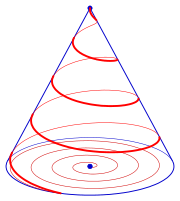
Two well-known spiral
Conical spirals
If in the --plane a spiral with parametric representation
is given, then there can be added a third coordinate , such that the now space curve lies on the cone with equation :
Spirals based on this procedure are called conical spirals.
- Example
Starting with an archimedean spiral one gets the conical spiral (see diagram)

Spherical spirals
If one represents a sphere of radius by:
and sets the linear dependency for the angle coordinates, one gets a
Spherical spirals were known to Pappus, too.
Remark: a rhumb line is not a spherical spiral in this sense.
-
Spherical spiral
-
Loxodrome
A
In nature
The study of spirals in
A model for the pattern of
where n is the index number of the floret and c is a constant scaling factor, and is a form of Fermat's spiral. The angle 137.5° is the golden angle which is related to the golden ratio and gives a close packing of florets.[14]
Spirals in plants and animals are frequently described as whorls. This is also the name given to spiral shaped fingerprints.
-
An artist's rendering of a spiral galaxy.
-
Sunflower head displaying florets in spirals of 34 and 55 around the outside.
As a symbol
A spiral like form has been found in Mezine, Ukraine, as part of a decorative object dated to 10,000 BCE.[citation needed] The spiral and
Spirals can be found throughout pre-Columbian art in Latin and Central America. The more than 1,400
Spiral shapes, including the
Spirals are also a symbol of
-
Cucuteni Culture spirals on a bowl on stand, a vessel on stand, and an amphora, 4300-4000 BCE, ceramic, Palace of Culture, Iași, Romania
-
Mycenaean spirals on a burial stela, Grave Circle A, c.1550 BC, stone, National Archaeological Museum, Athens, Greece
-
Gothic Revival spiralling bell tower of the Maison des compagnons du tour de France, Nantes, unknown architect, c.1910
In art
The spiral has inspired artists throughout the ages. Among the most famous of spiral-inspired art is
See also
- Celtic maze (straight-line spiral)
- Concentric circles
- DNA
- Fibonacci number
- Hypogeum of Ħal-Saflieni
- Megalithic Temples of Malta
- Patterns in nature
- Seashell surface
- Spirangle
- Spiral vegetable slicer
- Spiral stairs
- Triskelion
References
- ^ "Spiral | mathematics". Encyclopedia Britannica. Retrieved 2020-10-08.
- ^ "Spiral Definition (Illustrated Mathematics Dictionary)". www.mathsisfun.com. Retrieved 2020-10-08.
- ^ "spiral.htm". www.math.tamu.edu. Retrieved 2020-10-08.
- ^ "Math Patterns in Nature". The Franklin Institute. 2017-06-01. Retrieved 2020-10-08.
- ^ a b "Spiral, American Heritage Dictionary of the English Language, Houghton Mifflin Company, Fourth Edition, 2009.
- ^ Weisstein, Eric W. "Archimedean Spiral". mathworld.wolfram.com. Retrieved 2020-10-08.
- ^ Weisstein, Eric W. "Hyperbolic Spiral". mathworld.wolfram.com. Retrieved 2020-10-08.
- ISBN 978-0-8493-8916-0. Retrieved 2022-03-03.
- ^ "Slinky -- from Wolfram MathWorld". Wolfram MathWorld. 2002-09-13. Retrieved 2022-03-03.
- ISSN 0378-4371.
- ISBN 3322853659, 9783322853653, S. 132
- ^ Thompson, D'Arcy (1942) [1917]. On Growth and Form. Cambridge : University Press ; New York : Macmillan. pp. 748–933.
- ^ Ben Sparks. "Geogebra: Sunflowers are Irrationally Pretty".
- ISBN 978-0-387-97297-8.
- ^ Anthony Murphy and Richard Moore, Island of the Setting Sun: In Search of Ireland's Ancient Astronomers, 2nd ed., Dublin: The Liffey Press, 2008, pp. 168-169
- ^ "Newgrange Ireland - Megalithic Passage Tomb - World Heritage Site". Knowth.com. 2007-12-21. Archived from the original on 2013-07-26. Retrieved 2013-08-16.
- Boston Museum of Fine Arts, illustrated in John Boardman, Jasper Griffin and Oswyn Murray, Greece and the Hellenistic World (Oxford History of the Classical World) vol. I (1988), p. 50.
- ^ "Rock Art Of Latin America & The Caribbean" (PDF). International Council on Monuments & Sites. June 2006. p. 5. Archived (PDF) from the original on 5 January 2014. Retrieved 4 January 2014.
- ^ "Rock Art Of Latin America & The Caribbean" (PDF). International Council on Monuments & Sites. June 2006. p. 99. Archived (PDF) from the original on 5 January 2014. Retrieved 4 January 2014.
- ^ "Rock Art Of Latin America & The Caribbean" (PDF). International Council on Monuments & Sites. June 2006. p. 17. Archived (PDF) from the original on 5 January 2014. Retrieved 4 January 2014.
- ^ Jarus, Owen (14 August 2012). "Nazca Lines: Mysterious Geoglyphs in Peru". LiveScience. Archived from the original on 4 January 2014. Retrieved 4 January 2014.
- ^ Harrison, Paul. "Pantheist Art" (PDF). World Pantheist Movement. Retrieved 7 June 2012.
- ISBN 978-0-231-15302-7.
- ^ 2012 A Piece of Mind By Wayne A Beale
- ^ http://www.blurb.com/distribution?id=573100/#/project/573100/project-details/edit (subscription required)
- ^ Stark, Tanja (4 July 2012). "Spiral Journeys : Turning and Returning". tanjastark.com.
- ^ Stark, Tanja. "Lecture : Spiralling Undercurrents: Archetypal Symbols of Hurt, Hope and Healing". Jung Society Melbourne.
Related publications
- Cook, T., 1903. Spirals in nature and art. Nature 68 (1761), 296.
- Cook, T., 1979. The curves of life. Dover, New York.
- Habib, Z., Sakai, M., 2005. Spiral transition curves and their applications. Scientiae Mathematicae Japonicae 61 (2), 195 – 206.
- Dimulyo, Sarpono; Habib, Zulfiqar; Sakai, Manabu (2009). "Fair cubic transition between two circles with one circle inside or tangent to the other". Numerical Algorithms. 51 (4): 461–476. S2CID 22532724.
- Harary, G., Tal, A., 2011. The natural 3D spiral. Computer Graphics Forum 30 (2), 237 – 246 [1] Archived 2015-11-22 at the Wayback Machine.
- Xu, L., Mould, D., 2009. Magnetic curves: curvature-controlled aesthetic curves using magnetic fields. In: Deussen, O., Hall, P. (Eds.), Computational Aesthetics in Graphics, Visualization, and Imaging. The Eurographics Association [2].
- Wang, Yulin; Zhao, Bingyan; Zhang, Luzou; Xu, Jiachuan; Wang, Kanchang; Wang, Shuchun (2004). "Designing fair curves using monotone curvature pieces". Computer Aided Geometric Design. 21 (5): 515–527. .
- Kurnosenko, A. (2010). "Applying inversion to construct planar, rational spirals that satisfy two-point G2 Hermite data". Computer Aided Geometric Design. 27 (3): 262–280. S2CID 14476206.
- A. Kurnosenko. Two-point G2 Hermite interpolation with spirals by inversion of hyperbola. Computer Aided Geometric Design, 27(6), 474–481, 2010.
- Miura, K.T., 2006. A general equation of aesthetic curves and its self-affinity. Computer-Aided Design and Applications 3 (1–4), 457–464 [3] Archived 2013-06-28 at the Wayback Machine.
- Miura, K., Sone, J., Yamashita, A., Kaneko, T., 2005. Derivation of a general formula of aesthetic curves. In: 8th International Conference on Humans and Computers (HC2005). Aizu-Wakamutsu, Japan, pp. 166 – 171 [4] Archived 2013-06-28 at the Wayback Machine.
- Meek, D.S.; Walton, D.J. (1989). "The use of Cornu spirals in drawing planar curves of controlled curvature". Journal of Computational and Applied Mathematics. 25: 69–78. .
- Thomas, Sunil (2017). "Potassium sulfate forms a spiral structure when dissolved in solution". Russian Journal of Physical Chemistry B. 11 (1): 195–198. S2CID 99162341.
- Farin, Gerald (2006). "Class a Bézier curves". Computer Aided Geometric Design. 23 (7): 573–581. .
- Farouki, R.T., 1997. Pythagorean-hodograph quintic transition curves of monotone curvature. Computer-Aided Design 29 (9), 601–606.
- Yoshida, N., Saito, T., 2006. Interactive aesthetic curve segments. The Visual Computer 22 (9), 896–905 [5] Archived 2016-03-04 at the Wayback Machine.
- Yoshida, N., Saito, T., 2007. Quasi-aesthetic curves in rational cubic Bézier forms. Computer-Aided Design and Applications 4 (9–10), 477–486 [6] Archived 2016-03-03 at the Wayback Machine.
- Ziatdinov, R., Yoshida, N., Kim, T., 2012. Analytic parametric equations of log-aesthetic curves in terms of incomplete gamma functions. Computer Aided Geometric Design 29 (2), 129—140 [7].
- Ziatdinov, R., Yoshida, N., Kim, T., 2012. Fitting G2 multispiral transition curve joining two straight lines, Computer-Aided Design 44(6), 591—596 [8].
- Ziatdinov, R., 2012. Family of superspirals with completely monotonic curvature given in terms of Gauss hypergeometric function. Computer Aided Geometric Design 29(7): 510–518, 2012 [9].
- Ziatdinov, R., Miura K.T., 2012. On the Variety of Planar Spirals and Their Applications in Computer Aided Design. European Researcher 27(8–2), 1227—1232 [10].













